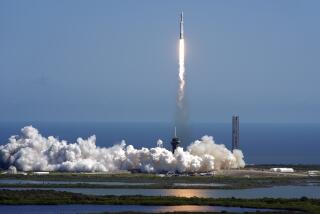SpaceX splashdown: Capsule returns 2,668 pounds of science samples
Less than 250 miles west of Baja California, SpaceXâs Dragon capsule successfully splashed down Tuesday after spending more than three weeks in outer space on a NASA mission.
When the cone-shaped unmanned capsule hit the water at 9:34 a.m. PDT, it marked the end of the mission carried out by the Hawthorne company, officially known as Space Exploration Technologies Corp.
PHOTOS: A ânew eraâ: Private-sector space mission
The privately built and operated spacecraft docked with the International Space Station on March 3 after being launched two days prior.
âSPLASHDOWN! At 9:34am PT, #Dragon splashed down safely in the Pacific. Welcome home!,â the company tweeted.
The crew of the space station sent the capsule back in the pre-dawn hours for a trip that lasted about five hours.
After the capsule reentered Earthâs atmosphere, its three main parachutes billowed open about five minutes before splashdown. The orange-and-white-striped parachutes, each 116 feet in diameter, slowed the craftâs descent to 16 to 18 feet per second.
The craft bobbed in the water until two 24-foot rigid-hull inflatable boats and a 100-foot ship equipped with a crane recovered it. The capsule is set to arrive Wednesday night at the Port of Long Beach.
âRecovery ship has secured Dragon. Powering down all secondary systems. Cargo looks A ok,â tweeted SpaceX founder and chief executive Elon Musk.
The Dragon capsule returned with about 2,668 pounds of science samples from human research, biology and biotechnology studies, physical science investigations and education activities for NASA, the space agency said. The cargo will be delivered to NASA.
SpaceXâs mission began March 1 with a launch of its Falcon 9 rocket, carrying the Dragon capsule, from Cape Canaveral, Fla. The capsule was packed with more than 1,200 pounds of food, scientific experiments and other cargo for delivery to the six crew members aboard the space station.
Shortly after blastoff, the company ran into a thruster issue with the Dragon as it orbited around the Earth. However, in a matter of hours, engineers resolved the problem with the thrusters, which help maneuver the capsule. It later docked with the station.
The resupply-and-cargo-return mission was SpaceXâs second of 12 under a $1.6-billion contract with NASA. The other official mission was in October; a demonstration mission took place in May.
NASA wants to turn over the job of carrying cargo and crews into space to private industry. Meanwhile, the agency plans to focus on deep-space missions to land astronauts on asteroids and Mars.
SpaceX, founded in 2002, employs nearly 3,000 scientists, engineers and technicians, many of whom work at the companyâs sprawling production facility in Hawthorne, where it builds rockets and capsules.
Next commercial company on the launch pad is Orbital Sciences Corp. of Dulles, Va., which has a test of its Antares rocket set for mid-April.
ALSO:
Southland aerospace firms brace for defense cuts
Northrop to close Carson facility in cost-cutting move
Boeing working to lift FAA grounding on 787 with test flight
More to Read
Inside the business of entertainment
The Wide Shot brings you news, analysis and insights on everything from streaming wars to production â and what it all means for the future.
You may occasionally receive promotional content from the Los Angeles Times.











